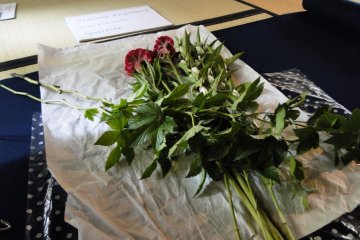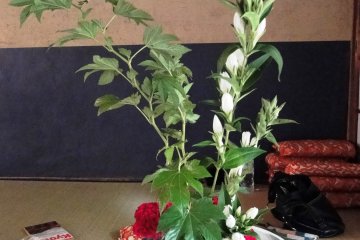A single bloom. A knobby twig, A stalk of leaves, perfectly arranged in a ceramic bowl. If you've traveled around Japan for any amount of time, chances are you've seen an example of ikebana, the art of Japanese flower arranging. These asymmetric yet eye-catching arrangements crop up at tea ceremonies, in fancy hotels, and even in large exhibitions around the islands. But if you ever wanted to try your own hand at ikebana, there's a new course in Kyoto aimed at explaining the ins and outs of this traditional art – Ami Kyoto.
Ami Kyoto is housed in the same carefully-restored machiya (townhouse) that hosts Tea Ceremony En. The course, which lasts an hour and fifteen minutes, is run by Kimiko Yamamoto. Kimiko has been studying ikebana for over a decade and she begins every course with a clear, concise history of Japanese flower arranging. There are also a few basic principles to understand, such as the use of negative or empty space in an ikebana arrangement and the various levels at which you want to place the flowers.
After the "learning" part of the class, it's time for the hands-on portion. Kimiko offers guests the chance to work with three flowers for each arrangement, always chosen from blooms or plants that are in season. On the day I attended, I worked with the simple green leaves of Japanese raspberry, the delicate buds of white gentian and the bright bushy blooms of cockscomb.
Kimiko watched and gently guided me while I attempted to assemble my masterpiece. If I had questions, she gladly offered answers or explanations but mostly let me find my own creativity. At the end, we critiqued the arrangement together. Her trained eye picked up on facets of my flower arrangement that I hadn't seen - two branches placed at the same exact angle (a no-no in ikebana), a tendency for me to make all of my branches stand up rather than let some drape over the bowl. Through her eyes, I was able to see what I was missing in my original arrangement and adjust accordingly to make it better.
Before Ami, I'd never had a real interest in ikebana. But thanks to Kimiko's expert instruction, I have a growing fascination with this incredibly unique traditional art.









